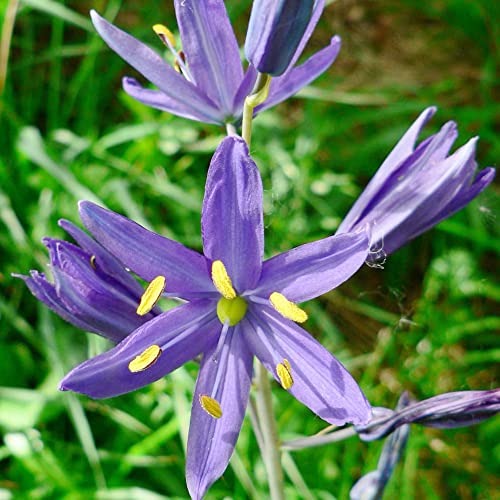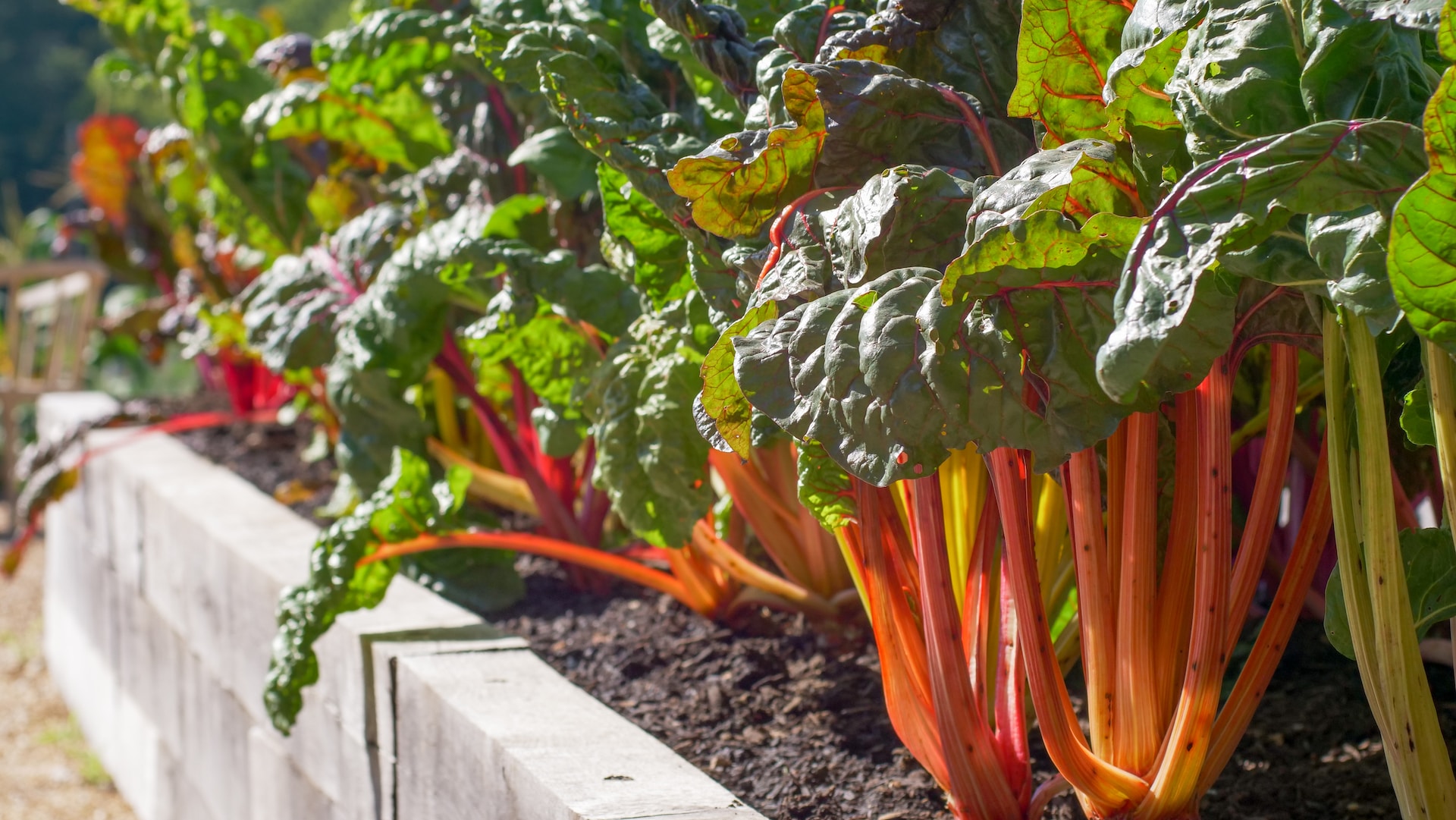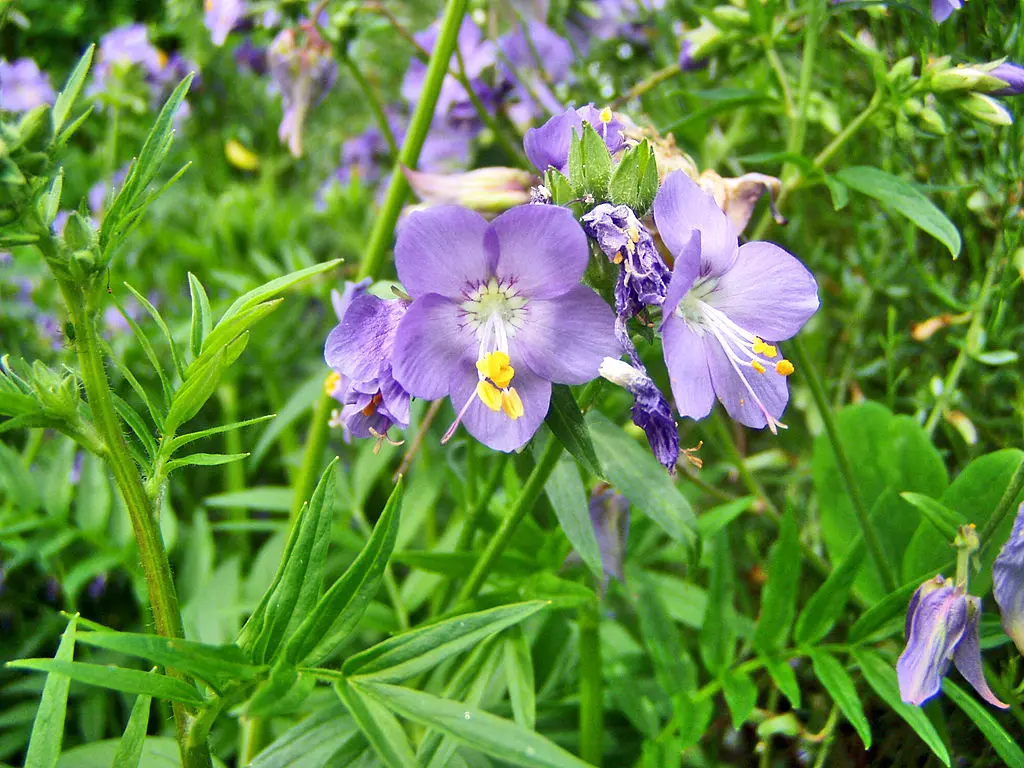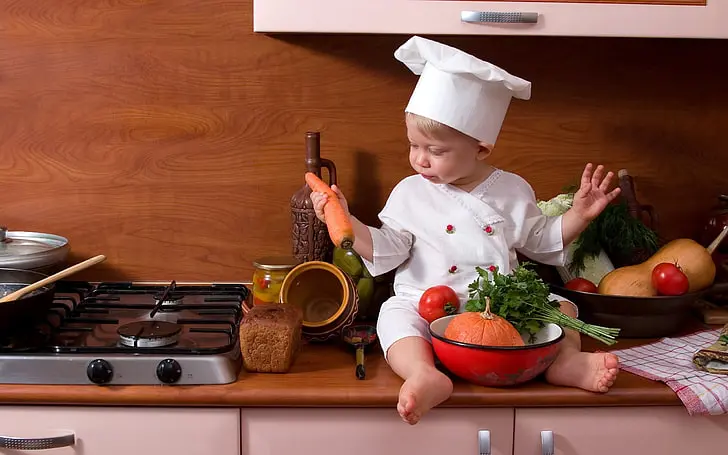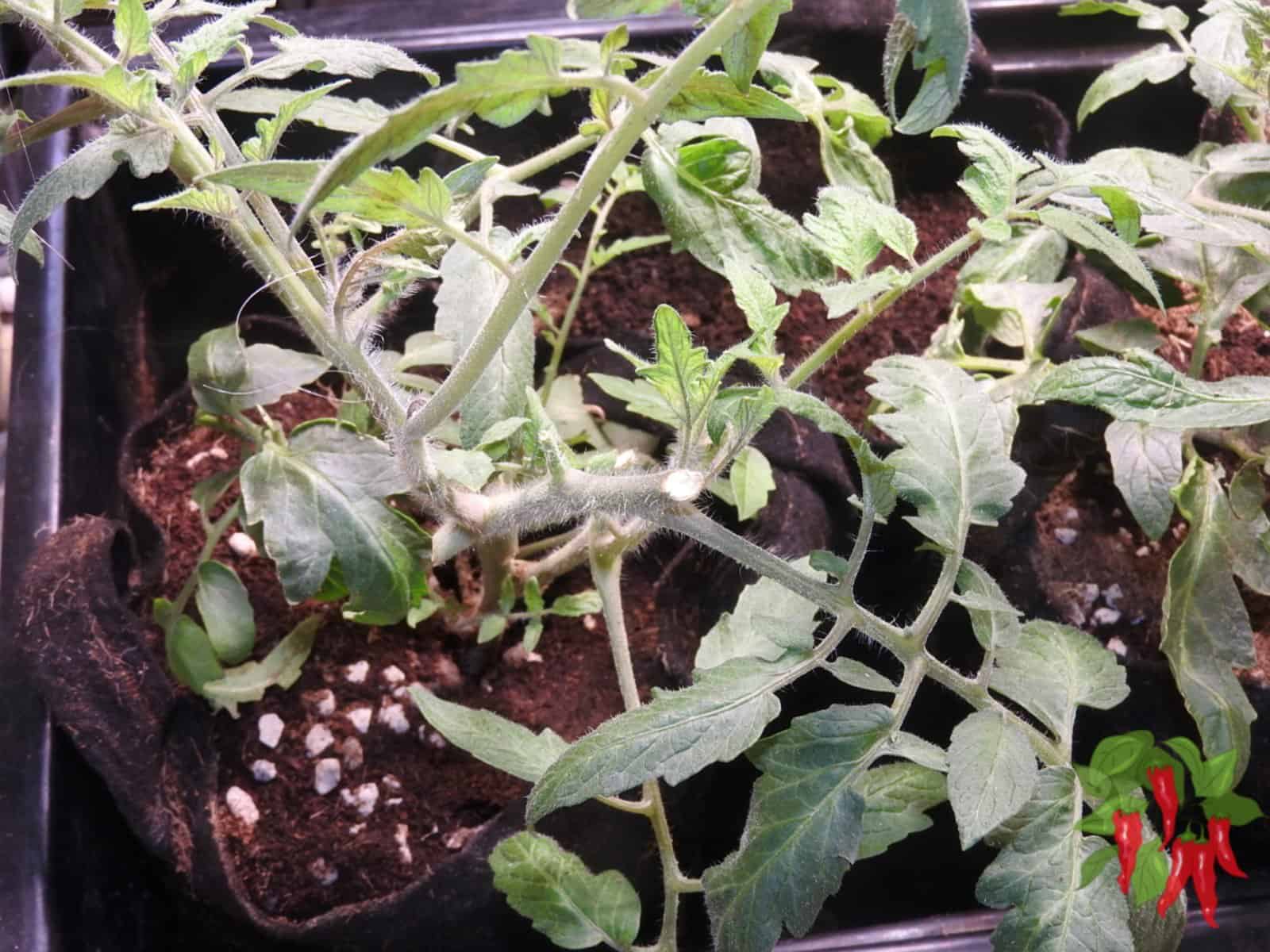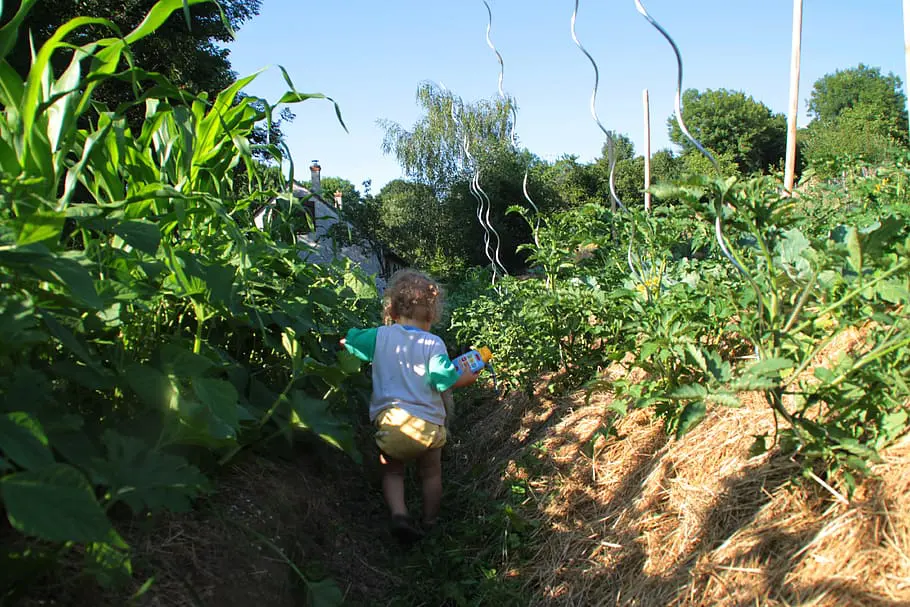This post contains affiliate links. If you buy something from one of our links we may earn a commission. Thanks
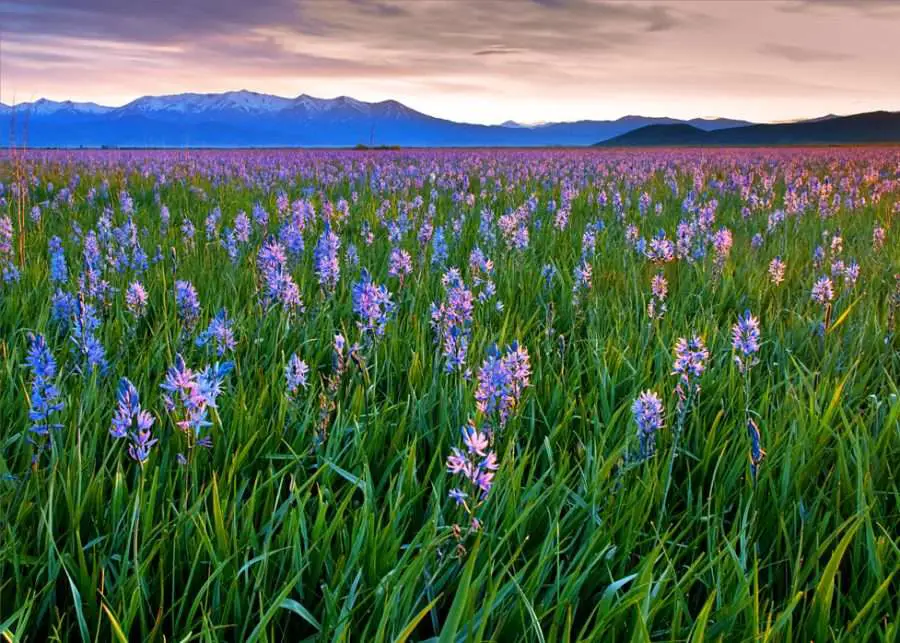
Discover the joy of growing Camassia in pots with our comprehensive guide! From choosing the right container to troubleshooting common issues, we’ve got you covered.
Ever wondered if you could enjoy the beauty of Camassia without a sprawling garden? Good news—you absolutely can!
Growing Camassia in pots is not only doable but also incredibly rewarding.
Whether you’re a seasoned gardener or a newbie with a green thumb, our comprehensive guide will walk you through everything you need to know.
So, let’s dive in and make your patio or windowsill a little more colorful!
Growing Camassia in Pots
Growing Camassia in pots is a practical and rewarding way to enjoy these beautiful blooms, especially if you’re short on garden space. Choose a pot that’s at least 8-12 inches in diameter and use loam-based compost for soil. Plant the bulbs with the pointy end up, cover with soil, and water generously. Place the pot in a well-lit area and water when the top inch of soil feels dry.
Camassia, a beautiful and versatile plant, has been gaining popularity among gardeners and plant enthusiasts. Camassia quamash was a staple food for Native Americans.
Known for its tall spires of blue, white, or occasionally pink star-like flowers, Camassia is a sight to behold.
But what if you’re short on garden space? Can these beauties be grown in pots? You bet!
In this article, we’ll explore everything you need to know about growing Camassia in pots, from the types of containers to use to troubleshooting common issues.
Camassia is a genus of plants in the asparagus family native to North America. Common names include camas, quamash, Indian hyacinth, camash, and wild hyacinth.
It grows in the wild in great numbers in moist meadows. They are perennial plants with basal linear leaves measuring 20 to 80 centimetres (8 to 32 in) in length, which emerge early in the spring.
They grow to a height of 30 to 130 cm (12 to 50 in), with a multi-flowered stem rising above the main plant in summer. The six-petaled flowers vary in color from pale lilac or white to deep purple or blue-violet. https://en.wikipedia.org/wiki/Camassia
Can Camassias be Grown in Pots?
Let’s clear the air first. Yes, Camassias can absolutely be grown in pots. While some people might think that these plants require a lot of space, the truth is, they’re quite adaptable.
Growing Camassia in pots has several advantages:
Space-Saving: Ideal for Those with Limited Garden Space
Not everyone has the luxury of a sprawling backyard or garden, and that’s perfectly okay! Growing Camassia in pots is a fantastic solution for those who are working with limited outdoor space.
Maybe you have a small patio, balcony, or even just a sunny windowsill. No worries, a pot of Camassia can fit there.
This way, you don’t have to miss out on the joy of gardening. You can still have your little oasis of nature, right where you are.
Mobility: Easily Move the Pots to Optimize Sunlight or Bring Them Indoors During Harsh Weather
One of the best things about container gardening is the mobility it offers. Plants can be finicky about their sunlight, and Camassia is no different. They prefer full sun.
If you notice your plant isn’t getting enough light, it’s as simple as picking up the pot and moving it to a sunnier spot.
And let’s not forget about those unpredictable weather days. If a sudden frost or heatwave is in the forecast, you can easily bring your potted Camassia indoors to protect it.
Control: Easier to Manage Soil Quality and Watering
When you’re growing Camassia in the ground, you’re somewhat at the mercy of the existing soil and drainage conditions. But in a pot?
You’re the master of that mini-environment. You can tailor the soil mix to meet the specific needs of Camassia, ensuring it has all the nutrients it needs.
Plus, watering becomes a more straightforward affair. You won’t have to worry about natural drainage patterns or competing plants.
You can control the moisture level more precisely, making sure your Camassia is neither thirsty nor drowning.
So there you have it, three compelling reasons why growing Camassia in pots is a fantastic idea.
Each point offers its own set of benefits, making container gardening an attractive option for both novice and experienced gardeners alike.
How Do You Grow Camassia in Containers?
 Growing Camassia in pots isn’t rocket science, but there are some guidelines you should follow for the best results.
Growing Camassia in pots isn’t rocket science, but there are some guidelines you should follow for the best results.
Planting Times
The best time to plant camas bulbs is in the fall, ideally about 6 weeks before the first hard frost is expected in your area.
Planting in the fall allows the bulbs to establish a strong root system before winter sets in, setting the stage for a beautiful bloom come springtime.
You can also plant camas bulbs in the spring, but there are a few things to keep in mind.
Spring-planted bulbs will likely not bloom until the following year, as they prefer a period of cold dormancy to trigger flowering.
Also, you’ll want to wait until late spring to make sure the danger of frost has passed and that soil temperatures are consistently above 50°F (10°C) before planting.
So, while fall is the traditional planting time for camas bulbs, spring can work too.
Types of Containers
Material: Opt for Ceramic or Terracotta Pots That Offer Good Drainage
When it comes to choosing the right material for your pot, ceramic and terracotta are your best friends. Why, you ask?
Well, these materials are excellent at providing the drainage that Camassia bulbs crave.
They’re porous, which means they allow excess water to escape, preventing your plant from sitting in a soggy mess.
Plus, they come in all sorts of designs and colors, so you can match them with your decor. It’s a win-win!
Size: Choose a Pot That’s at Least 8-12 Inches in Diameter
Size matters. Especially when you’re talking about pots for your Camassia. A pot that’s too small can cramp your plant’s style, literally.
The bulbs need room to grow and spread their roots. A pot that’s at least 8-12 inches in diameter gives your Camassia the space it needs to thrive.
Soil Requirements
Type: Moist soil and well-drained soil
This type of soil retains moisture but drains well, making it the ideal home for your Camassia bulbs.
Coco coir is a good choice but amended potting mix can also be used.
pH Level: Neutral to Slightly Acidic
The pH level of your soil can make a big difference in how well your Camassia grows.
These plants prefer neutral to slightly acidic soil, with a pH level between 6 and 7.
If you’re not sure about your soil’s pH, you can easily test it with a soil pH kit. If needed, you can adjust the pH by adding lime to raise it or sulfur to lower it.
Coco Coir for Camas Bulbs
Coco coir mixed with 25% perlite makes an excellent pH neutral growing medium for camas plants with excellent drainage and good water retention qualities
Camas Planting Steps
Alright, you’ve got your pot and soil ready, and you’re itching to get those Camassia bulbs in the ground. Well, in the pot, to be exact.
Planting is the main event of gardening, and it’s easier than you might think.
Let’s break down the steps so you can get your Camassia bulbs snug and cozy in their new home.
Fill the Pot with Soil Up to 2 Inches from the Top
First things first, let’s talk about setting the stage for your Camassia bulbs. You’ll want to fill your chosen pot with soil, but not to the brim.
Leave about 2 inches of space from the top. This gap is crucial for a couple of reasons.
One, it gives you room to add the bulbs and additional soil. Two, it acts as a buffer when you water, preventing the water from spilling over.
Plant the Camas Bulbs with the Pointy End Facing Upwards
Now, onto the star of the show the Camassia bulbs. These little guys have a flat end and a pointy end. Make sure the pointy end is facing upwards when you plant them.
Why? Well, that pointy end is where the stem will eventually sprout, reaching for the sky. It’s like the plant’s own little arrow, saying, “Hey, I want to grow this way!”
So, give it a helping hand by planting it in the right direction.
Cover with Soil and Water Generously
Last but not least, it’s time to tuck your Camassia bulbs in. Cover them with the remaining soil, filling up to the level you initially left empty.
Once they’re all snug, give them a generous watering. This initial watering helps settle the soil and ensures that the bulbs make good contact with their new environment.
Growing Camassia From Seed
How about growing these beauties from seed? Maybe bulbs are not available but you still want to grow them.
In this section, we’ll guide you through the steps to successfully grow Camassia from seed. Let’s get started!
Camassia From Seed Directions
Collecting Seeds: The first step in your Camassia seed journey is, of course, getting the seeds.
You can either collect them from an existing plant after the flowers have faded and seed pods have formed, or you can purchase them from a reputable supplier like Amazon.
Stratification: Camassia seeds generally need a cold stratification period to mimic winter conditions and encourage germination.
Place the seeds in a bag of moist sand or peat moss and store them in the refrigerator for about 4-6 weeks.
Sowing: After the stratification period, it’s time to sow your seeds. Fill a seed tray or pots with good-quality seed compost or coco coir.
Scatter the seeds on the surface and lightly cover them with more compost or a layer of vermiculite.
Germination Conditions: Place the seed tray in a warm, well-lit area but out of direct sunlight.
Keep the soil consistently moist but not waterlogged. Germination can take anywhere from 2 to 6 weeks.
Transplanting: Once your seedlings have at least two sets of true leaves and are sturdy enough to handle, you can transplant them into individual pots.
Use a coco coir and perlite mix and make sure the pots have good drainage.
Growing On: Keep your young Camassia plants in a sunny to partially shaded spot and water them regularly.
Once they’re big enough, you can transplant them to their final location, whether that’s a larger pot or directly into the garden.
Flowering: Keep in mind that Camassia grown from seed may take a few years to flower, so patience is key.
But when they do bloom, you’ll have the added satisfaction of knowing you grew these beauties from scratch.
And there’s your comprehensive guide to growing Camassia from seed. It’s a bit of a journey, but the end result is well worth the effort. Happy gardening!
Watering and Fertilization
Now that your Camassia bulbs are all settled in, you might be wondering how to keep them happy and thriving.
Well, it’s all about the right balance of water and nutrients. Let’s dive into the details.
Water Once the Top Inch of Soil Feels Dry
Watering is essential, but too much can be a bad thing.The trick is to stick your finger into the soil up to an inch deep.
If it feels dry, it’s time to water. This method ensures you’re not overwatering, which can lead to root rot.
Use a Balanced Liquid Fertilizer Once a Month
Feeding your Camassia is the next big step. A balanced liquid fertilizer is your go-to here. Why liquid, you ask?
Well, liquid fertilizers are more easily absorbed through the soil, giving your plants a quicker nutrient boost.
And by balanced, we mean a fertilizer that has equal parts nitrogen, phosphorus, and potassium along with necessary trace elements.
This all-around nutrition helps your Camassia grow strong stems, vibrant leaves, and, of course, those stunning flowers we’re all aiming for.
With a little love and care, you’ll see those beautiful blooms in no time. Happy planting!
How Tall Does Camassia Get?
Camassia plants can vary in height, but most varieties will reach around 30 to 36 inches.
In pots, the height might be slightly less due to restricted root growth.
What Grows Well with Camassia?
The art of companion planting is kind of like setting up your best friends on a date but for plants.
When it comes to Camassia, there are some plants that just seem to bring out the best in each other.
Let’s delve into some of the top picks for your Camassia’s perfect match.
Polygonatum (Solomon’s Seal): Adds a Contrasting Texture
First up, we have Solomon’s Seal, a plant that’s as intriguing as its name. What makes it a great companion for Camassia? Texture, my friend.
Solomon’s Seal has arching stems with dangling, tubular flowers that provide a lovely contrast to Camassia’s upright spikes.
Dicentra (Bleeding Heart): Complements Camassia with Its Unique Shape
Next on the list is the Bleeding Heart, a plant that’s as dramatic as it sounds.
Its heart-shaped flowers are not just eye-catching but also offer a unique shape that complements Camassia’s star-like blooms.
Euphorbia: Its Acid Yellow Color Makes Camassia’s Blue Pop
Last but not least, let’s talk about Euphorbia. If you’re aiming for a color contrast that’ll make your neighbors do a double-take, Euphorbia is your go-to.
Specifically, consider Euphorbia polychroma or Euphorbia characias ‘Wulfenii’ for their vibrant, acid-yellow bracts. These shades make the blue in Camassia look even more vivid.
A Word of Caution
While these plants make excellent companions for Camassia, it’s essential to remember that Camassia prefers moisture. So, avoid pairing it with plants that love dry soil.
Do Camassia Bulbs Spread?
In a garden setting, Camassia bulbs can spread over time. However, in pots, the spreading is naturally contained.
If you notice your Camassia becoming too crowded, it may be time to repot or divide the bulbs.
What Zone Does Camassia Grow In?
Camassia is hardy and can grow in USDA zones 4 through 8. If you’re growing them in pots, you have the added advantage of moving them indoors during extreme weather conditions.
Why Don’t My Camassias Flower?
So, you’ve done everything by the book, but your Camassia is still not showing off those gorgeous blooms? Don’t worry; you’re not alone.
Many gardeners face this issue, and most of the time, it’s something that can be easily fixed.
Let’s dig into some of the most common reasons why your Camassia might be holding back on the flower show.
A. Insufficient Light:
If your Camassia isn’t flowering, it might be craving more light.
Make sure you place your pot in an area that receives plenty of sunlight, ideally at least 6 to 8 hours a day.
If you’ve been keeping it in a shady corner, it’s time to move it to a sunnier spot.
Overcrowding: Too Many Bulbs in One Pot Can Lead to Poor Flowering
Imagine being at a party where it’s so packed you can’t even move. Not much fun, right? Your Camassia bulbs feel the same way when they’re overcrowded.
Too many bulbs in one pot can lead to poor flowering because they’re all competing for the same nutrients and space.
If you’ve been a little too generous with the number of bulbs you planted, consider thinning them out or moving some to another pot.
Give them room to breathe, and you’ll likely see more blooms.
Poor Soil Quality: Ensure You’re Using Nutrient-Rich Soil
Last but not least, let’s talk about soil quality. Just like you wouldn’t thrive on a diet of junk food, your Camassia needs nutrient-rich soil to bloom.
If you skimped on the soil quality, your plant might produce fewer flowers or none at all.
Make sure you’re using a good potting mix with added compost, coco coir, or a specialized bulb mix that’s rich in nutrients.
If you’re unsure, you can always add a slow-release fertilizer to give your Camassia the nutrients it needs.
So, if your Camassia is being a bit shy about flowering, take a closer look at these factors.
A little tweak here and there could make all the difference, turning your potted Camassia into the blooming beauty it’s meant to be.
Growing Camas Bulbs in Pots FAQs
So you’ve got your Camassia all potted up and you’re buzzing with questions, right? Don’t worry, you’re not alone.
We’ve all been there, staring at our potted plants and wondering, “Am I doing this right?”
That’s why we’ve put together this handy FAQ section to tackle some of the most burning questions about growing Camassia in pots. Let’s dive in!
Q. How Often Should I Water My Potted Camassia?
A. The age-old question of watering. It’s like asking how often you should call your mom. There’s no one-size-fits-all answer.
But there are some good guidelines. For Camassia, the rule of thumb is to water when the top inch of soil feels dry to the touch.
Q. Can Camassia Survive Winter in Pots?
A. Winter is coming, and you’re wondering if your Camassia is going to make it through the chilly months, right? Well, the good news is that Camassia is pretty hardy.
However, if you live in an area with harsh winters, it’s a good idea to move your pots to a sheltered location or even indoors.
Q. Is Camassia Toxic to Pets?
A. We all love our furry friends and the last thing we want is to put them in harm’s way. The good news is that Camassia is generally not considered toxic to pets.
However, it’s always a good idea to consult with your vet if you have concerns. Better safe than sorry, right?
Q. When Should I Plant Camas Bulbs?
A. Timing is everything, especially when it comes to planting bulbs. For Camassia, the best time to plant is in the fall, about 6 weeks before the first hard frost.
Q. Can You Eat Camas Bulbs?
A. While some types of camas bulbs have been traditionally eaten by Indigenous peoples, it’s crucial to note that not all camas bulbs are edible.
Some are toxic and can be easily confused with the edible varieties. So, unless you’re an expert, it’s best to admire your Camassia for its beauty rather than its taste.
Growing Camassia in Pots Conclusion
Growing Camassia in pots is not only possible but also incredibly rewarding.
With the right container, soil, and a bit of care, you can enjoy these stunning blooms even if you don’t have a garden.
So go ahead, give Camassia a try in pots, and let its beauty grace your home or patio.
And that’s a wrap on a comprehensive guide to growing Camassia in pots. Happy gardening!





